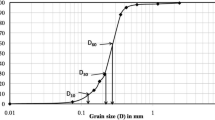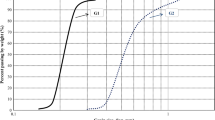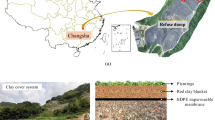Abstract
In this work, the interest was focused on the study of clogging and durability of soils clogged using the Biosealing® process. During this process, bacteria initially present in the soil are fed with an appropriate nutritive solution. The aim is to provoke phenomena resulting in a sharp permeability drop. The durability tests objective was to measure the effect of a progressive increase in hydraulic gradient values on the permeability of totally clogged samples. The grain size of the materials varies from 0.1 to 10 mm (permeability values between 1.1 10−2 and 10−5 m/s). The results showed that clogging occurs regardless of grain size distribution. However, longer time was needed to obtain total clogging for coarse materials. For the durability tests, the behavior is depending on the grain size. For coarse materials a drastic increase in the permeability was obtained when the hydraulic gradient was increased; however, no changes were observed for the fine materials in spite of the imposed high hydraulic gradient values. These results are due to the higher specific surface area accessible to the bacteria in the case of fine materials, whereas this area is lower for the coarse materials. In order to improve the clogging durability of the coarse materials, the nutrition solution and a clay suspension were injected alternatively. The clay presence reduces the treatment duration and improves the durability of coarse materials, especially for them presenting higher uniformity coefficient values. Analytical parameters monitoring like pH, electrical conductivity, redox potential and dissolved oxygen concentration were carried out to follow the bacteria activity.








Similar content being viewed by others
References
Bedmar AP, Araguas LA (2002) Detection and prevention of leaks from dams. AA Balkema Publishers, Netherlands
McDonald JE, Curtis NF (1999) Repair and rehabilitation of Dams: Case Studies. Headquarters, US. Army Corps of Engineers, Washington DC
Zhang H, Gue H, Li M, Cheng X (2011) Experiment research from macro to micro on microbial induced clogging by adding potato soup in Beijing sand column. Geo-Frontiers Congress 2011, March 13–16, 2011 | Dallas, Texas, United States
Blauw M, Lambert JMW, Latil MN (2009) BioSealing: a method for in situ sealing of leakages. Geo-Engineering, Deltares
Martin RE, Bouwer EJ, Hanna LM (1992) Application of clean-bed filtration theory to bacterial deposition in porous media. Environ Sci Tech 26(5):1053–1058
Ross N, Villemur R, Deschenes L, Samson R (2001) Clogging of a limestone fracture by stimulating groundwater microbes. Water Res 35(8):2029–2037
Hand VL, Lloyd JR, Vaughan DJ, Wilkins MJ, Boult S (2008) Experimental studies of the influence of grain size, oxygen availability and organic carbon availability on bioclogging in porous media. Environ Sci Technol 42(5):1485–1491
Van Beek VM, Den Hamer D, Lambert JWM, Latil MN, van der Zon WH (2007) Biosealing, a natural sealing mechanism that locates and repairs leaks. In: Proceedings of the 1th international conference on self healing materials, Noordwijk aan Zee, Dordrecht Springer 2007 (ed) The Netherlands, 18–20
Liao H, Zhao K, Lambert JWM, Veenbergen V (2007) Experimental study on biosealing technology for Seepage prevention. GeoDelft Neth pp. 1–8
Baveye P, Vandevivere P, Hoyle BL, Deleo PC, Sanchez De Lozada D (1998) Environmental impact and mechanisms of the biological clogging of saturated soils and aquifer materials. Crit Rev Env Sci Tec 28(2):123–191
Engesgaard P, Seifert D, Herrera P (2006) Bioclogging in Porous Media: Tracer Studies. Riverbank Filtration Hydrology. In Proceedings of the NATO Advanced Research Workshop on Riverbank Filtration: IV: Earth and Environmental Sciences (SA Hubbs (ed) 60 Springer Netherlands, 3–118
Seifert D, Engesgaard P (2007) Use of tracer tests to investigate changes in flow and transport properties due to bioclogging of porous media. J Contam Hydrol 93(1–4):58–71
Sutherland IW (2001) Biofilm exopolysaccharides: a strong and sticky framework. Microbiolo 147:3–9
Bonala MVS, Reddi LN (1998) Physicochemical and biological mechanisms of soil clogging: an overview. ASCE Geotech Special Publ 78:43–68
Taylor SW, Jaffe PR (1990) Biofilm growth and the related changes in the physical properties of a porous medium 1 Experimental investigation. Water Resour Research 26(9):2153–2159
Dupin HJ, McCarty PL (2000) Impact of colony morphologies and disinfection on biological clogging in porous media. Environ Sci Technol 34(8):1513–1520
Bielefeldt AR, Illangasekare T, Uttecht M, LaPlante R (2002) Biodegradation of propylene glycol and associated hydrodynamic effects in sand. Water Res 36(7):1707–1714
Kim DS, Fogler HS (2000) Biomass evolution in porous media and its effects on permeability under starvation conditions. Biotechnol Bioeng 69(1):47–56
Stewart TL, Fogler HS (2001) Biomass plug development and propagation in porous media. Biotechnol Bioeng 72(3):353–363
Paksy A, Powrie W, Robinson JP, Peeling L (1998) A laboratory investigation of anaerobic microbial clogging in granular landfill drainage media. Geotechnique 48(3):389–401
Vandevivere P, Baveye P (1992) Effect of bacterial extracellular polymers on the saturated hydraulic conductivity of sand columns. Appl Environ Microbiol 58(5):1690–1698
Thullner M, Zeyer J, Kinzelbach W (2002) Influence of microbial growth on hydraulic properties of pore networks. Transp Porous Media 49(1):99–122
Xia L, Zheng X, Shao H, Xin J, Sun Z, Wang L (2016) Effects of bacterial cells and two types of extracellular polymers on bioclogging of sand columns. J Hydrol 535(1):293–300
Sanchez de Lozada D, Vandevivere P, Baveye P, Zinder S (1994) Decrease of the hydraulic conductivity of sand columns by Methanosarcina barkeri. World J Microbiol Biotechnol 10(3):325–333
Cleveland CC, Liptzin D (2007) C:n:p stoichiometry in soil: is there a “redfield ratio” for the microbial biomass? Biochem 85:235–252
Hong Z, Chen W, Rong X, Cai P, Dai K, Huang Q (2013) The effect of extracellular polymeric substances on the adhesion of bacteria to clay minerals and goethite. Chem Geol 360–361:118–125
Chaerun SK, Tazaki K (2005) How kaolinite plays an essential role in remediating oil polluted seawater. Clay Miner 40(4):481–491
Courvoisier E, Dukan S (2009) Improvement of Escherichia coli growth by kaolinite. App Clay Sci 44(1–2):67–70
Rong X, Huang Q, Chen W (2007) Microcalorimetric investigation on the metabolic activity of Bacillus thuringiensis as influenced by kaolinite, montmorillonite and goethite. Appl Clay Sci 38(1–2):97–103
Farah T (2015) Effet du Bioclomatage sur les proprieties hydrauliques de materiaux granulaires. Université de Lyon, Lyon
Biarez J, Hicher PY (1994). Elementary mechanics of soil behaviour: saturated remoulded soils. Brookfield, VT: A.A. Balkema. Rotterdam
Van Der Zon WH, Den Hamer DA, Lambert JWM, Molendijk WO (2007) Biosealing Patent, US-8256994-B2
Knigt L, Novakowski K, Ramsay J (2008) Biostimulation of groundwater Microorganisms in fractured Bedrock throught nutrient addition: a field trial. 1st Int conf BioGeoCivel Eng, 23–25 June 2008
Begot C, Desnier I, Daudin JD, Labadie JC, Lebert A (1996) Recommendations for calculating growth parameters by optical density measurements. J Microbiol Methods 25:225–232
Yang S, Ngwenya BT, Butler IB, Kurlanda H, Elphick SC (2013) Coupled interactions between metals and bacterial biofilms in porous media: implications for biofilm stability, fluid flow and metal transport. Chem Geol 337–338:20–29
Ivanov V, Chu J (2008) Applications of microorganisms to geotechnical engineering for bioclogging and biocementation of soil in situ. Rev Environ Sci Biotechnol 7(2):139–153
Vlamakis H, Aguilar C, Losick R, Kolter R (2013) Control of cell fate by the formation of an architecturally complex bacterial community. Genes Develop 22(7):945–953
Guo H, Cheng X, Li M (2013) Experimental analysis of bio-stimulated sealing process in environmental geotechnical engineering. Sci China Technol Sci 56(3):732–738
Perujo N, Romaní AM, Sanchez-Vilaa X (2019) A bilayer coarse-fine infiltration system minimizes bioclogging: the relevance of depth-dynamics. Sci Total Environ 669:559–656
Gandhi HP, Ray RM, Patel RM (1997) Exopolymer production by Bacillus species. Carbohydr Polym 34(4):323–327
Garrett TR, Bhakoo M, Zhang Z (2008) Bacterial adhesion and biofilms on surfaces. Prog Nat Sci 18(10):1049–1056
Farah T, Souli H, Fleureau JM, Kermouche G, Fry JJ, Girard B, Aelbrecht D, Lambert J, Haarkes M (2016) Which durability for bioclogging treatment of soils? J Geotech Geoenviron Eng 142(9):1–11
Pravelic P, Dillon P (1996) The impact of two seasons of stormwater injection of groundwater quality in south Australia. Proc. Intern. Symp Artif. Recharge Groundwater Hels Finla Ed. Kivimaki T Suokko 105–110
Vetter A, Mangelsodorf K, Wolfgang M, Rauppach K, Schettler G, Vieth Hillebrand A (2012) Variation in fluid chemistry and membrane phospholipid fatty acid composition of bacterial community in a cold storage groundwater system during clogging events. Appl Geochem 27:1278–1290
Tan Y, Bond WJ, Rovira AD, Brisbane PG, Griffin DM (1991) Movement through soil of a biological control agent. Pseudomonas Fluorescens Soil Biol Biochem 23(9):821–825
Huysman F, Verstraete W (1993) Effect of cell surface characteristics on the adhesion of bacteria to soil particles. Biol Fertil Soils 16(1):21–26
Tay JH, Liu QS, Liu Y (2001) The effects of shear force on the formation, structure and metabolism of aerobic granules. Appl Microbiol Biotechnol 57:227–233
Liu Y, Tay JH (2002) The essential role of hydrodynamic shear force in the formation of biofilm and granular sludge. Water Res 36:1653–1665
Alimova A, Roberts M, Katz A, Rudolph E, Steiner JC, Alfano RR, Gottlieb P (2006) Effects of smectite clay on biofilm formation by microorganisms. Biofilms 3(1):47–54
Stucki JW, Kostka JE (2006) Microbial reduction of iron in smectite. C R Geosci 338(6):468–475
Chaerun SK, Tazaki K, Asada R (2003) Double function of bentonite and kaolinite as adsorbents and “Microbial growth-support media” for degradation of crude oil. Heavy Oil Spil. Russ. Tanker Nakhodka 1997 Ecoresponsibility Earth Sense K Tazaki Ed. Univ. Press 21st Century COE Kanazawa Univ Jpn pp 253–277
Wu J, Wu Y, Lu J (2008) Laboratory study of the clogging process and factors affecting clogging in a tailings dam. Environ Geol 54:1067–1074
Holm J (2000) Effect of biomass growth on the hydrodynamic properties of groundwater aquifers. Technical University of Denmark, Lyngby (Denmark)
Kildsgaard J, Engesgaard P (2002) Tracer tests and image analysis of biological clogging in a two dimensional sandbox experiment. Groundwater Moni Remed 22:60–67
Funding
The authors thank EDF for financing the work.
Author information
Authors and Affiliations
Corresponding author
Ethics declarations
Conflict of interest
The authors declared that they have no conflict of interest.
Additional information
Publisher's Note
Springer Nature remains neutral with regard to jurisdictional claims in published maps and institutional affiliations.
Rights and permissions
About this article
Cite this article
Souli, H., Fleureau, JM., Farah, T. et al. Bioclogging in Porous Media: Effect of the Presence of Clay. Indian Geotech J 52, 315–327 (2022). https://doi.org/10.1007/s40098-021-00569-w
Received:
Accepted:
Published:
Issue Date:
DOI: https://doi.org/10.1007/s40098-021-00569-w




